Guest post by Terry Whittaker
Reflecting the national trend, water vole populations in the Dark Peak region of the Peak District National Park have become reduced to a few small, disconnected colonies. Therefore it’s hard to say why they are doing so well in the conduit that drains Hallam Moor, eventually running into Yorkshire Water’s Redmires Reservoir a couple of miles west of Sheffield.
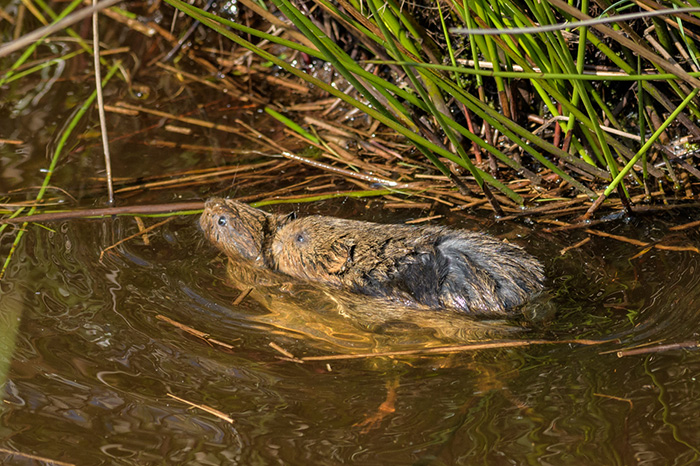
This narrow, peat-infused watercourse has reasonable habitat that improves as it nears the reservoirs, affording plenty of food and cover in the form of heather and various rushes and grasses. The conduit passes through moorland managed for driven grouse shooting and it’s possible that the voles benefit from the intensive predator control that brings. Whatever the reason, the core habitat supports a high density of water voles.
A public footpath follows the conduit for around half of its length leading to hiking routes on to the open hill. There is well maintained, level access to wild country for wildlife-watching families who visit this area rich in upland bird species, like curlew, lapwing, golden plover, ring-ousel and of course, red grouse.
Dogs behaving badly
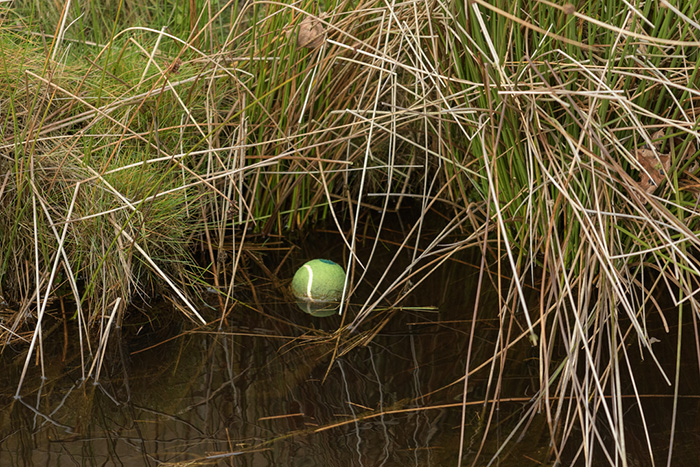
For the same reason this path is popular with dog walkers. According to 2018 research by the Pet Food Manufacturers Association there are 9 million dogs in the UK, a 5% increase over the previous year and 26% of households own one. Quite a few households own more than one. Dog walking is not only good for our dogs, it’s good for us too, improving both physical and mental health. There is no requirement for dogs on public footpaths to be on a lead but they are supposed to be under close control and not stray from the right of way. Unfortunately some dogs make straight for the water and some owners encourage them to do so by throwing balls into the stream. Claire has been watching and photographing the water voles here for 4 years. She told me “…the number of dogs entering the water has been steadily increasing, even when the owners knew the voles were there”.
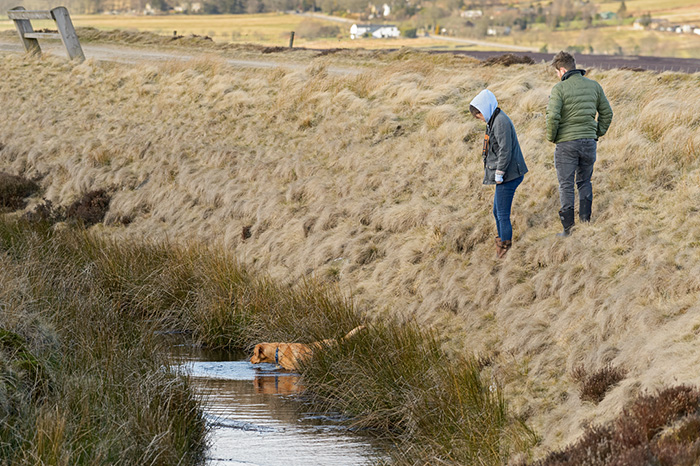
Disturbance to wildlife by dogs is well documented but mostly with regard to birds, particularly ground-nesting species. It’s difficult to quantify what effect these dogs are having on the water vole population apart from the obvious disturbance when the voles dive into the water or down the nearest burrow when a dog approaches. Water voles need to eat around 80% of their own body weight each day and this means they spend a considerable amount of time feeding. One concern is that when dog disturbance is more frequent, say on weekends or holidays, the voles don’t have enough time to feed and can fail to thrive.
Good fences make good neighbours
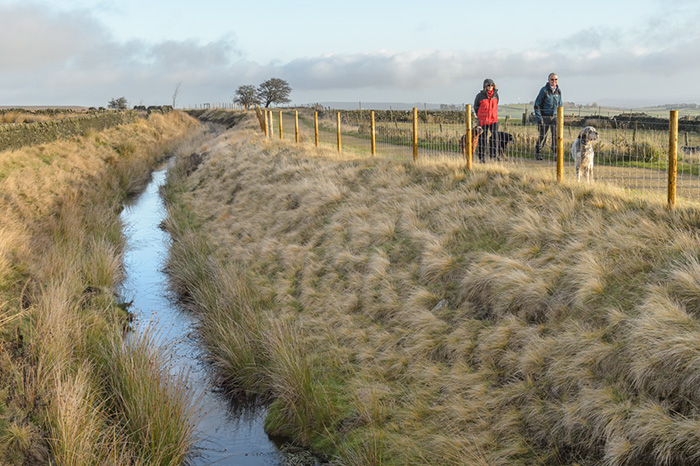
Angus Hunter is the Biodiversity officer for Sheffield City Council. Already concerned about the loss of water vole populations around Sheffield he felt action was required to protect this vital colony: “ …I watched people let their terriers into the stream and conscious of how few water voles we had left I asked Yorkshire Water’s Biodiversity Officer to fence it off. Fencing was the only effective option I could see”. The fence runs for around 700 metres and includes the core population and some of the best habitat. However, the water vole population extends for another kilometre or so and possibly even further into small, moorland streams.
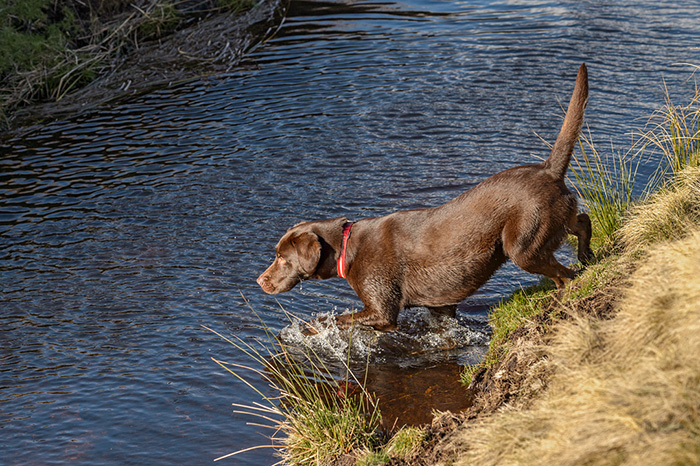
I mentioned to Angus that what happens now is those owners who allow or encourage their dogs into the water do so immediately as the fence ends. This results in increased disturbance in one place and bank erosion where the dogs enter. Angus: “ I would love to get the fence extended but unfortunately we have no budget for this… I think a bit of localised disturbance is fine as long as the water voles have a safe zone where they can breed and feed safely”. I asked if there had been any complaints about the fence: “There have been no reports of complaints so far. The only feedback I have had is that the (water vole) population has increased and that the fenced off areas are being used by snipe, woodcock and grouse for nesting. So all feedback has been very supportive…”
the (water vole) population has increased and the fenced off areas are being used by snipe, woodcock and grouse
What happens next
From a photographer’s perspective, it will be interesting to see if the fence will have any effect on the vole’s behaviour. I know from experience at other sites that water voles that regularly see and hear people, even close by, can become quite confiding and much easier to watch, as long as those people and their dogs can’t get any closer. It’s possible that being restricted to a fixed distance by the fence will make it easier for the many people who use this path to watch water voles, including those with dogs, to see them. Claire told me: ” I’ve seen the voles out regularly this winter from early February, the earliest I’ve had reliable sightings and I’ve had good encounters with them sitting out happily foraging on the bank, with little to no reaction to human voices”.
Fortunately, we have an excellent idea of what happened next from a conservation perspective thanks to George Lee-Harris of Sheffield Hallam University. In partnership with Sheffield and Rotherham Wildlife Trust he carried out extensive research during 2018 into the differences in water vole activity between the fenced and unfenced sections of this population. His research will be published in the next few months but he very kindly provided the gist of his findings.
He told me that the level of dog walking was very high at the site with professional dog walkers with up to 8 dogs a regular occurrence. He observed “hunting-like behaviour” with dogs actively sniffing at water vole burrows. There’s an accepted belief amongst dog owners I’ve talked with at other water vole sites that the dogs are just having fun when chasing through a stream and as they never catch anything, no harm is done. But George told me: “I received multiple unprompted accounts from local residents of dogs regularly catching water voles before the implementation of the fence.” And “On a side note – I also recorded many instances of dogs barking at or chasing lapwings, curlews and grouse while they attempted to protect their nests.”
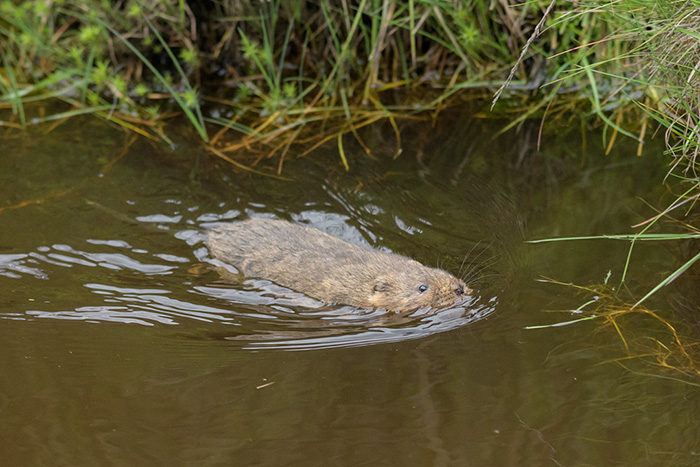
I have been photographing the water voles at Redmires for only a couple of years. I love dogs but like all wildlife photographers I find their sudden appearance combined with the sudden disappearance of whatever I was photographing extremely annoying. This can create a skewed perspective on just how much disturbance is being caused and whether it has any population-level effect. I admit to having been a bit sceptical as to whether this fence was necessary, particularly as this colony, unlike so many others, appeared to be thriving. I asked George whether the fence was making a difference. He said: “The difference between the two sections in terms of water vole activity (measured through latrine counts in 100m sections – a commonly used method to measure relative abundance) was very clear. The site has an incredibly high density of water voles in comparison to sites studied in previous research, and abundance was still relatively high in the non-fenced sections. However, during my study period, water vole abundance was significantly higher in the fenced than the non-fenced section, even when differences in habitat and distance from the road were controlled for…I concluded that water vole activity was lower in sections with higher disturbance from dog-walking”.
What are we going to do now?
I thought there would be more complaints about the Redmires fence. At a stream where I used to help manage the water vole population, which also ran beside a public footpath, people would go to great lengths to let their dogs in to the water. Even to the point of squeezing through the low barbed wire fence where stream access was easiest and visible. And some owners really didn’t like being asked to keep their dogs out of the water even when the reason was explained to them. Eventually it became obvious that sacrificing one short stretch to dog access was the practical solution, leaving the rest of the stream disturbance free.
If the Redmires fence extended for the entire length of the conduit and dogs had no access to the water at all it might attract more criticism. George told me: “ Most dog-walkers I spoke to were supportive of the fence, and apologetic when their unleashed dog had been engaging sniffing out water vole burrows in the non-fenced section”.
So clearly we can add disturbance from dogs to the litany of problems facing our beleaguered water vole populations. How many colonies around the country, already on the precipice of extinction due to unsympathetic habitat management, have been, or could be in future, pushed over the edge by disturbance?
The last word from George:” So in my opinion, fencing to protect populations in key areas where recreational disturbance is high is an important pathway for future landscape scale conservation work. I think issues relating to recreational impacts, and particularly dog-walking, will become greater in the coming years as dog ownership continues to rise… Innovative solutions and pragmatic compromises are definitely needed, but we need to do it without alienating the dog-walkers!”
Terry Whittaker is a photographer and wildlife conservationist specialising in the relationship between people and nature. www.terrywhittaker.com
